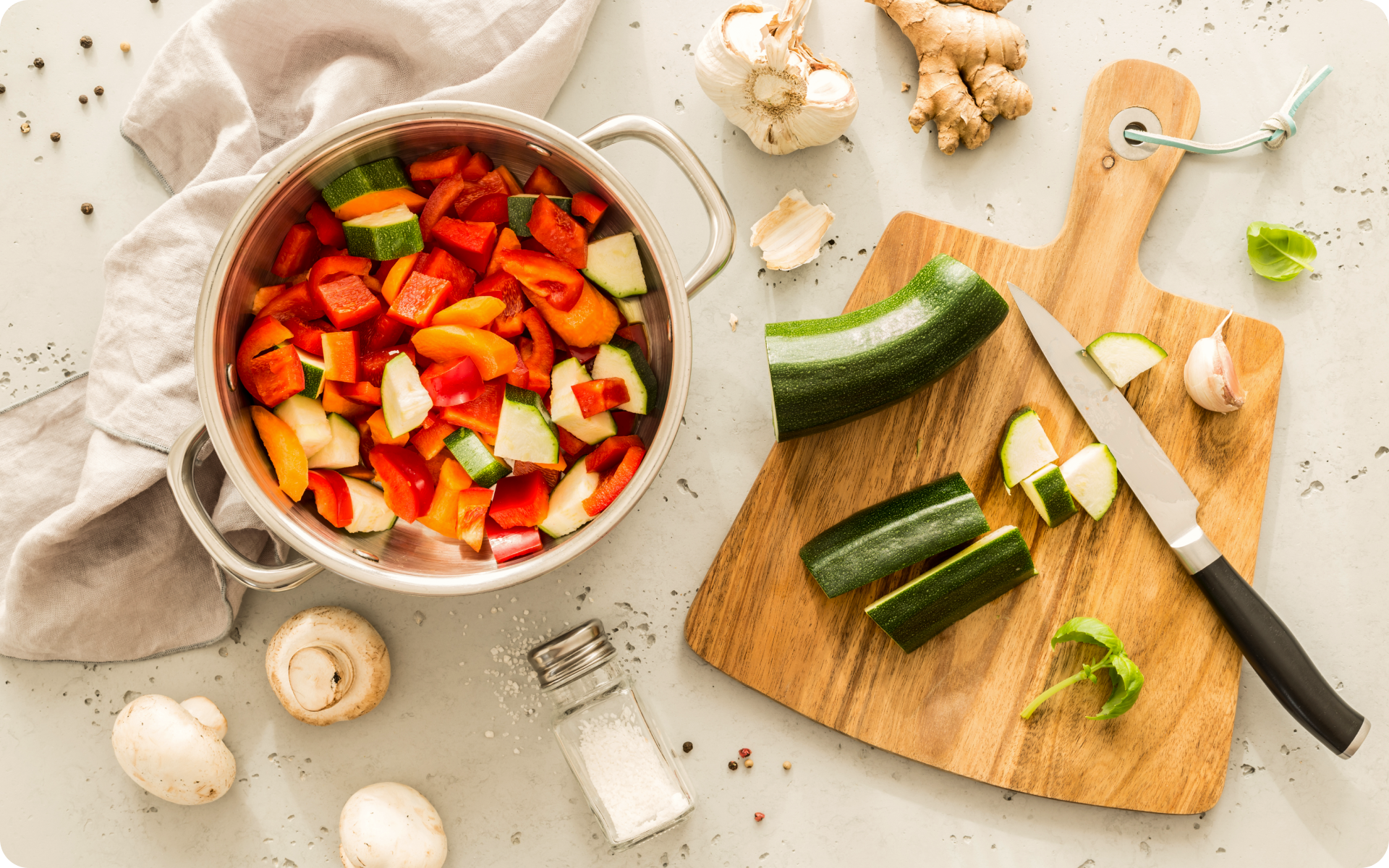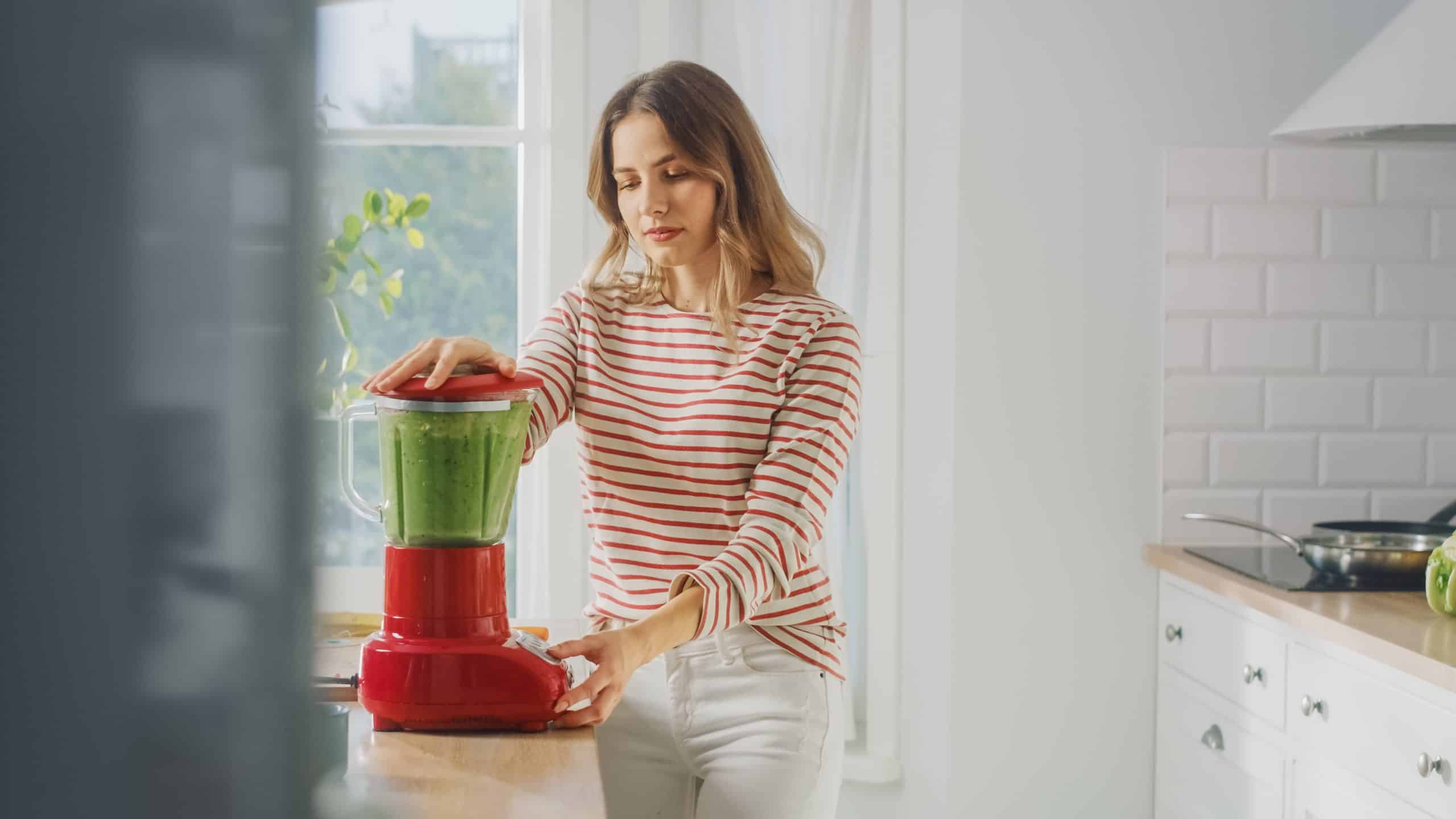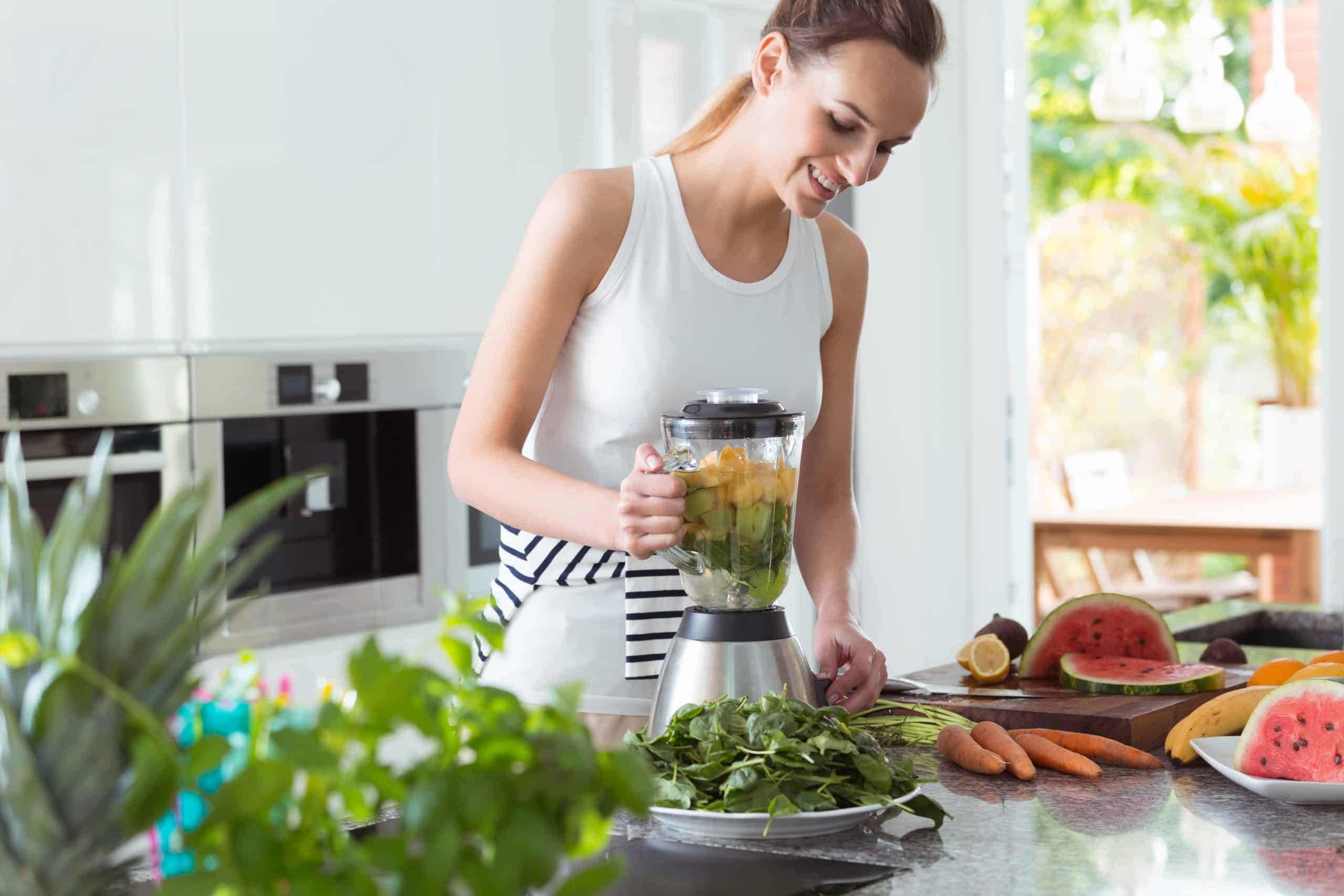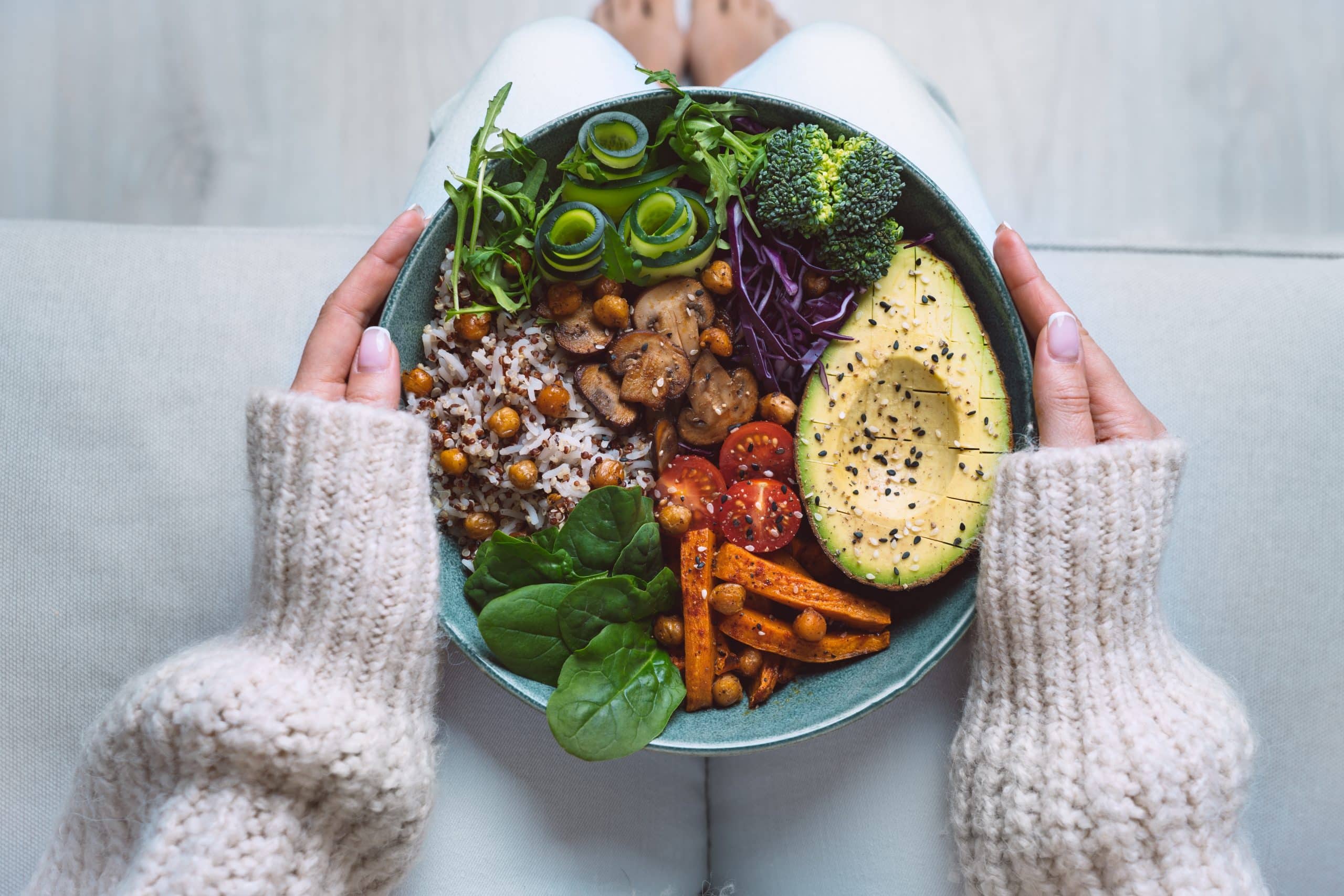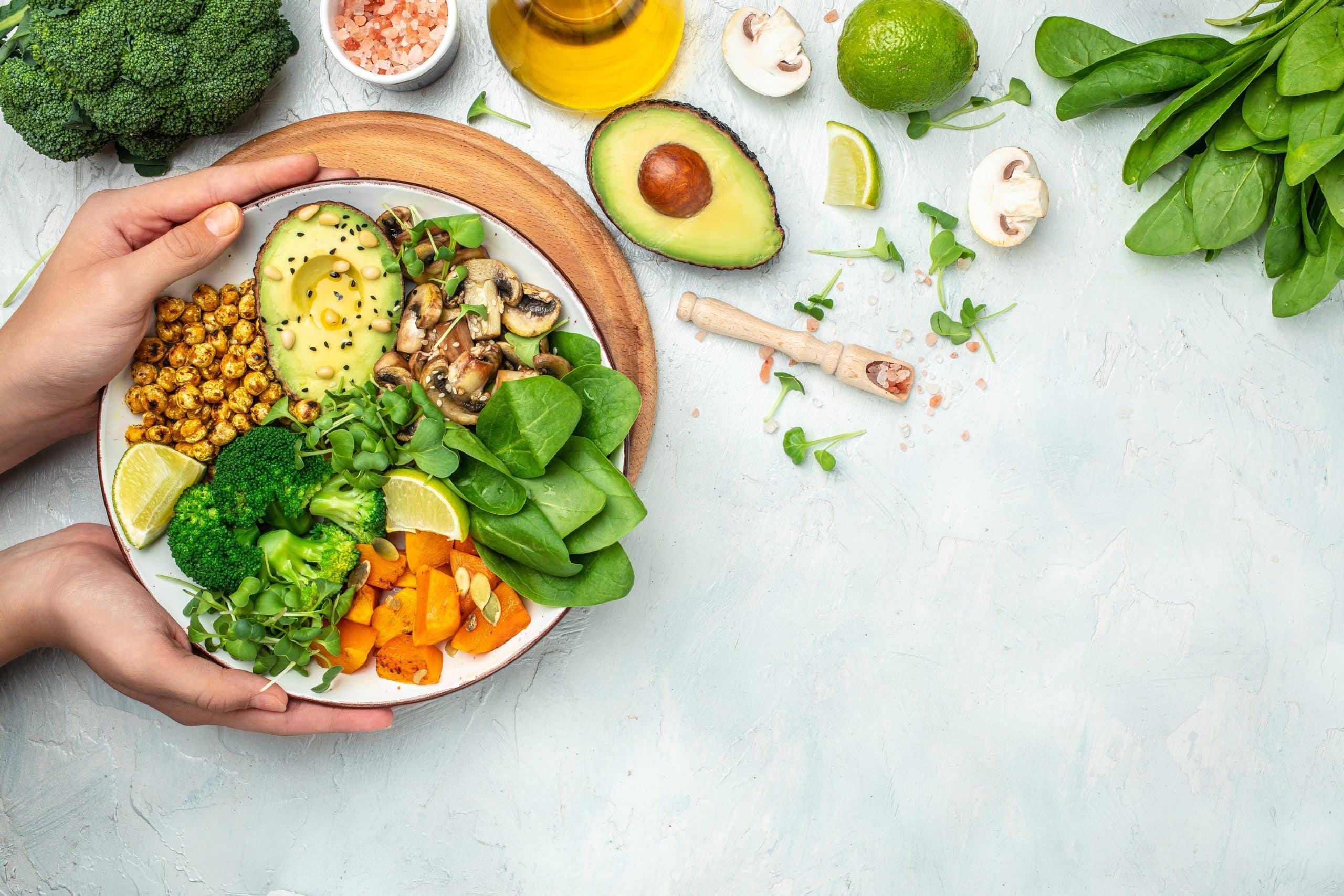Do you ever find yourself eating an entire bag of chips and still feeling famished? Or maybe you’ve polished off a pint of ice cream and are left craving more? The problem is, calorie-dense foods can leave us feeling unsatisfied, which leads to overeating and weight gain.
Research into how cravings work has suggested that eating calorically dense foods too often may lead to a habitual desire for them (9).
At the same time, low-calorie, high-volume foods can help us feel full longer and make it easier to control our portions. These seemingly magical foods are loaded with nutrients, fiber, and water, which helps your body stay fueled and satisfied throughout the day.
These qualities are another reason why high-volume foods help with fat loss. So, why not “stuff yourself skinny” with these delicious and filling options?
What Are High-Volume, Low-Calorie Foods?
There are a number of qualities that make a food high-volume and low-calorie. Generally, these foods have:
High Water Content
High-volume, low-calorie foods are made up of a significant amount of water, such as fruits and vegetables. The high water content helps with hydration and adds bulk to foods without the additional calories.
Water takes up space in the stomach, which leads to a feeling of fullness and satiety that reduces the urge to overeat (11). In addition, plain water, sparkling water, or lemon water are all zero-calorie drinks that add no calories to your daily total.
High Fiber Content
High-volume, low-calorie foods are also high in fiber, which is an essential component in maintaining digestive health (2).
Fiber regulates bowel movements, reduces inflammation, lowers cholesterol levels, and helps maintain a healthy weight. Fiber content also keeps you satiated for longer periods of time, which reduces your overall food intake (13).
High Nutrient Density
High-volume, low-calorie foods are typically nutrient-dense, which means that they provide essential vitamins and minerals while being low in calories (15). Nutrient density ensures the body gets all the nutrients it requires to function optimally.
Reasons why BetterMe is a safe bet: a wide range of calorie-blasting workouts, finger-licking recipes, 24/7 support, challenges that’ll keep you on your best game, and that just scratches the surface! Start using our app and watch the magic happen.
Low-Calorie Density
Calorie density refers to the amount of calories that are contained in a given weight or volume of food. High-volume, low-calorie foods have a lower calorie density, which means they contain fewer calories per serving. This makes them an ideal choice for weight loss or maintaining a healthy weight.
Low Fat Content
Fat is a concentrated source of energy and has more than double the calories of carbohydrates and proteins. High-volume, low-calorie foods are typically low in fat, which helps reduce overall calorie intake while still providing essential nutrients and fiber (18).
High Protein Content
Protein is an essential macronutrient and can help increase satiety and boost metabolism (4). During digestion, protein takes longer to break down than carbohydrates, so it remains in the stomach for a longer period of time.
This helps keep you feeling full and reduces unhealthy food cravings. High-volume, low-calorie foods, such as legumes and lean meats, are great for this purpose.
What Foods Are High in Volume and Low in Calories?
Below are some of the most popular and nutritious high-volume low-calorie foods:
1. Broccoli
Broccoli is a nutrient-dense vegetable that is high in fiber and low in calories. A cup of chopped, raw broccoli contains just 31 calories, but it provides a significant portion of your daily recommended intake of vitamins K and C (7).
One meal idea is to roast broccoli with garlic and lemon juice and serve it with grilled chicken or fish.
2. Cauliflower
Similar to broccoli, cauliflower is a vegetable that is high in fiber and low in calories. A cup of chopped raw cauliflower contains just 27 calories (8). Cauliflower is incredibly versatile and can be used as a low-calorie substitute for rice, pizza crust, or mashed potatoes.
One meal idea is to make cauliflower fried rice with shrimp and vegetables.
3. Strawberries
Strawberries are a nutrient-dense fruit that is high in fiber, vitamin C, and antioxidants. A cup of sliced strawberries contains just 53 calories (25). They make a delicious snack on their own, but can also be used in a variety of recipes such as smoothies or salads.
One meal idea is to mix sliced strawberries with spinach, feta cheese, and balsamic vinaigrette dressing for a refreshing and low-calorie salad.
4. Popcorn
Popcorn is a surprisingly low-calorie snack that is high in fiber and can help curb hunger. One cup of air-popped popcorn only contains 31 calories(24).
Instead of using pre-packaged microwave popcorn, buy plain kernels and pop them yourself on the stove top or in an air popper. One idea is to sprinkle popcorn with nutritional yeast and garlic powder to create a tasty and savory snack.
It’s important to remember that even low-calorie foods can be high in calories if they’re consumed in large quantities, so make sure you practice portion control. Incorporating these foods into balanced meals and snacks can help you feel satiated while staying within your calorie goals.
Read more: Boxing Calories Burned: Lose Weight by Punching
5. Zucchini
Zucchini is a versatile vegetable that is low in calories and high in fiber. A cup of sliced, raw zucchini contains only 20 calories and is a great source of vitamin C and potassium (16). One meal idea is to make zucchini noodles and top them with tomato sauce and grilled shrimp.
6. Watermelon
Watermelon is one of the most juicy low-calorie, high-volume fruits that is packed with vitamins and minerals. A cup of diced watermelon contains just 46 calories (27). Watermelon makes a refreshing snack or dessert on its own, but it can also be used in salads and smoothies.
One meal idea is to mix diced watermelon with feta cheese and fresh mint leaves for a delicious summer salad.
7. Carrots
Carrots are a root vegetable that is high in fiber, vitamin A, and potassium. A cup of sliced, raw carrots contains only 50 calories (17).
Carrots can be eaten raw as a snack or used in a variety of recipes such as salads, soups, and stews. One meal idea is to roast sliced carrots with herbs and serve them as a side dish to grilled chicken or tofu.
8. Shirataki Noodles
Shirataki noodles are low-calorie noodles made from konjac yam root and water. A 4-ounce serving of these noodles contains just 10 calories and virtually no carbs, which makes them perfect for anyone who is following a low-carb or low-calorie diet (22).
The noodles can be used in a variety of dishes, from stir-fries to salads. One meal idea is to make a cold shirataki noodle salad with cucumbers, bell peppers, and a soy sauce-based dressing.
9. Mushrooms
Mushrooms are low in calories and are a good source of fiber, B vitamins, and antioxidants. One cup of sliced, raw mushrooms contains only 15 calories (5).
Mushrooms are incredibly versatile and can be used in a variety of dishes, from soups to salads. One meal idea is to sauté mushrooms with onions and garlic and serve them over a bed of whole-wheat pasta.
10. Kelp Noodles
Kelp noodles are a low-calorie, low-carb alternative to traditional pasta. One 4-ounce serving of kelp noodles contains only 6 calories and very few net carbs. They have a slightly crunchy texture and can be used in a variety of cold or hot recipes, including stir-fries and salads.
11. Chicken Breast
Chicken breast is a lean source of protein that is low in calories and high in satiety value. A 3-ounce serving of boneless, skinless chicken breast contains only 140 calories, but it provides a whopping 26 grams of protein (6).
Try grilling chicken breast and pairing it with roasted vegetables for a filling, low-calorie meal.
12. Egg Whites
Egg whites are a low-calorie, high-protein food that can be used in a variety of recipes. One large egg white contains just 18 calories and provides over 3 grams of protein (12).
Try making an egg white omelet with spinach, mushrooms, and tomatoes for a low-calorie, high-volume breakfast or light lunch.
Find more low-calorie breakfast recipes you can try in our post: Low-Calorie Breakfast Recipes For Weight Loss
13. Chia Seeds
Chia seeds are a nutrient-dense food that can be used in many dishes, from smoothies to oatmeal. One tablespoon of chia seeds contains only 60 calories, but provides a high dose of fiber, omega-3 fatty acids, and antioxidants (21).
14. Brown Rice
Brown rice is a low-calorie, high-fiber carbohydrate that can be used as a base for many meals. One cup of cooked brown rice contains only 216 calories and provides 3.5 grams of fiber (10). Try using brown rice in stir-fries, salads, or as a side dish to grilled proteins.
15. Air-popped Sorghum
Air-popped sorghum is a gluten-free, low-calorie snack that is high in fiber and antioxidants. One cup of popped sorghum only contains 120 calories and provides 2 grams of fiber (23).
Try air-popping sorghum and seasoning it with your favorite herbs and spices for a healthy and satisfying snack.
BetterMe app will provide you with a host of fat-frying fitness routines that’ll scare the extra pounds away and turn your body into a masterpiece! Get your life moving in the right direction with BetterMe!
16. Lentils
Lentils are a versatile legume high in protein and fiber, which makes them a good choice for a satisfying vegetarian meal. One cup of cooked lentils contains only 230 calories but provides 18 grams of protein and 16 grams of fiber (14).
Lentils can be used in stews, soups, salads, and curries for a filling and nutrient-dense meal.
17. Whole Grains (quinoa, oatmeal, bulgur)
Whole grains are nutrient-dense carbohydrates that are low in calories and high in fiber. One cup of cooked quinoa, oatmeal, or bulgur contains approximately 230 calories and provides a good source of protein and fiber (19).
Try using these grains as a base for salads, stews, and stir-fries to make a filling and nutritious meal.
19. Turkey Breast
Turkey breast is a lean protein that is also low in calories and rich in nutrients such as vitamin B6 and niacin.
A 3-ounce serving of roasted turkey breast contains just 125 calories but provides over 26 grams of protein (26). Try using sliced turkey breast in sandwiches or salads for a low-calorie and protein-rich meal.
20. White Fish
White fish such as cod, haddock, and tilapia are lean proteins that are also low in calories. A 3-ounce serving of cooked white fish contains approximately 100 calories but provides over 16 grams of protein (20).
White fish can be broiled, grilled, baked, or used in fish tacos or bowls for a filling and healthy meal.
How to Use the High-Volume, Low-Calorie Foods List to Your Advantage
Volume eating is an approach to eating that is focused on incorporating large portions of low-calorie foods into your diet. This helps you feel full and satisfied but you consume fewer calories overall, which makes it a useful tool for weight loss and weight management.
By adding high-volume, low-calorie foods to your diet, you can increase the volume of your meals without overindulging in high-calorie, low-nutrient foods.
Benefits of Volume Eating
There are many benefits to incorporating volume eating into your diet, including:
- Increased feelings of satiety and fullness, which makes it easier to stick to your diet and reduce your overall calorie intake.
- A focus on nutrient-dense foods, which may help improve overall health and reduce the risk of chronic diseases.
- Improved digestion and bowel function due to the increased fiber and water content in high-volume foods.
- Convenience, as many high-volume foods such as fruits and vegetables can be prepared quickly and easily.
- Better weight management, as you can eat larger portions of more nutrient-dense foods, which helps reduce cravings for unhealthy snacks.
Tips for Volume Eating
Here are some tips to help you incorporate volume eating into your diet:
1. Control Portions
Even though high-volume, low-calorie foods are lower in calories, it is still important to control your portions. Use the foods on this list to balance out your low-calorie, high-volume snacks and meals, while also ensuring that they are portion-controlled.
For example, if you’re craving a sandwich, you can include high-volume foods such as lettuce and spinach to increase the volume of the sandwich without adding more calories.
Other tips for checking your portions and remaining within your calorie budget include using smaller plates, measuring out servings in advance, and reading food labels.
2. Meal Planning
Meal planning is an essential part of volume eating. By planning your meals and snacks ahead of time, you can ensure you have healthy options available.
Choose meals that have a balanced mix of protein, fiber, and healthy fats, and swap out high-calorie foods for high-volume, low-calorie options whenever possible.
Read more: Calories Burned Water Aerobics, or Why Aquafit is Good For Weight Loss
3. Shop Smart
When food shopping, you should look for high-volume, low-calorie food options. Fresh fruits and vegetables, whole grains, and lean proteins are all great choices (1).
Stock up on healthy snacks such as cut-up fruits and vegetables, nuts or seeds, and low-fat dairy products that you can have on hand when hunger strikes.
Other ways of ensuring you shop smart include stocking up on frozen fruits and vegetables, buying foods in bulk when possible, and shopping at local farmer’s markets for seasonal produce.
Going grocery shopping on a full stomach (so you don’t purchase impulsively) and sticking to a shopping list can also help. You should avoid the aisles that contain unhealthy snacks and ultra-processed foods.
4. Slow Down and Savor
Eating slowly and savoring your food is a key part of volume eating. This helps you recognize when you’re full and minimize overeating. You should take breaks between bites and pay attention to feelings of fullness and satisfaction.
Slowing down and savoring your food is also a good way of enjoying your meals and getting more pleasure out of food.
To amplify the benefits of this way of eating (also called mindful eating), try to limit any distractions while you eat. Avoid watching TV, scrolling through social media, or reading at mealtimes.
5. Be patient
Remember that adopting these tactics requires patience and consistency. It may take some time to adjust to a new eating routine, but the long-term benefits of feeling satisfied and nourished will be well worth the effort.
To ensure success, you should set small, achievable goals and track your progress. Review your successes and setbacks to help you stay motivated and on track.
FAQs
What are the lowest calorie foods that fill you up?
Leafy greens, such as spinach and kale, are some of the lowest calorie foods that can fill you up. They are high in water content and have a high fiber content, which helps promote satiety (13).
Other low-calorie, high-volume foods include fruits such as watermelon, strawberries, and cantaloupe, vegetables such as cucumbers, carrots, and celery, and lean proteins such as chicken breast and egg whites.
Check out our previous post to find out which zero-calorie foods you can include in your diet.
What is a low-calorie, high-volume snack?
A low-calorie, high-volume snack is one that provides a large portion of food with relatively few calories.
Some examples include air-popped popcorn, sliced apples with peanut butter, and Greek yogurt with berries. These snacks can help keep you feeling full between meals without adding excess calories to your diet (3).
What are high-calorie, small-volume foods?
High-calorie, small-volume foods are those that contain a lot of calories in a small serving size. Examples include fried foods, pastries and baked goods, high-fat meats, and sugary drinks. These types of food are often low in nutrients and can contribute to weight gain if they are consumed in excess.
Is 200 calories enough for lunch?
200 calories is not very much for a meal. A 200-calorie lunch may be enough if:
- You’re trying to lose weight and have already consumed a large nutritious breakfast.
- You intend to have a large dinner later in the day.
- Your lunch includes nutrient-dense foods such as lean proteins, whole grains, and vegetables.
However, if you have high energy needs or are fairly active, a 200-calorie lunch may not be enough to sustain you until your next meal.
When you eat too little for lunch, you’re opening the door to post-lunch snacking and overeating at dinner. You’re also more likely to feel tired and have difficulty concentrating for the rest of the day.
The Bottom Line
Incorporating volume eating into your diet can help you achieve your health and wellness goals, while still feeling satisfied and full.
By focusing on nutritionally dense, high-volume foods, controlling your portions, planning your meals, and paying attention to hunger and fullness signals, you can make volume eating a sustainable and enjoyable part of your daily routine.
DISCLAIMER:
This article is intended for general informational purposes only and does not serve to address individual circumstances. It is not a substitute for professional advice or help and should not be relied on for making any kind of decision-making. Any action taken as a direct or indirect result of the information in this article is entirely at your own risk and is your sole responsibility.
BetterMe, its content staff, and its medical advisors accept no responsibility for inaccuracies, errors, misstatements, inconsistencies, or omissions and specifically disclaim any liability, loss or risk, personal, professional or otherwise, which may be incurred as a consequence, directly or indirectly, of the use and/or application of any content.
You should always seek the advice of your physician or other qualified health provider with any questions you may have regarding a medical condition or your specific situation. Never disregard professional medical advice or delay seeking it because of BetterMe content. If you suspect or think you may have a medical emergency, call your doctor.
SOURCES
- 10 High-Fiber, Low-Calorie Foods (2012, achs.edu)
- A high-protein diet for reducing body fat: mechanisms and possible caveats (2014,nih.gov)
- Are mushrooms a good vegetarian alternative to meat? (2014,aicr.org)
- Breasts vs Thighs Which Is More Nutritious (2021,eatright.org)
- Broccoli, raw (2022, usda.gov)
- Cauliflower, raw (2018,usda.gov)
- Cravings (2021,harvard.edu)
- DIETARY GUIDELINES FOR AMERICANS(2020,health.gov)
- Eggs, Grade A, Large, egg white (2019, usda.gov)
- Effect of Pre-meal Water Consumption on Energy Intake and Satiety in Non-obese Young Adults (2018, ncbi.nlm.nih.gov)
- Lentils, sprouted, cooked, stir-fried, without salt (2019,usda.gov)
- Low-Energy-Dense Foods and Weight Management: Cutting Calories While Controlling Hunger (2012,cdc.gov)
- Nutrition Facts (2023,rochester.edu)
- Nutrition Facts Carrots, raw, 1 cup, strips or slices (2023,rochester.edu)
- Optimal Diet Strategies for Weight Loss and Weight Loss Maintenance (2021,nih.gov)
- Quinoa can be used in a variety of ways, including in soups, salads, main dishes, breads and crackers. (2015,ndsu.edu)
- Seafood Nutrition Overview Dietary Advice (2023,seafood health facts.org)
- Seeds are healthy sources of fiber (2015,msu.edu)
- SHIRATAKI NOODLES (2022, usda.gov)
- Significance of coarse cereals in health and nutrition: a review (2012,nih.gov)
- Snacks, popcorn, air-popped (Unsalted) (2019, usda.gov)
- Strawberries, raw (2019, usda.gov)
- Turkey, whole, breast, meat only, cooked, roasted (2019,usda.gov)
- Watermelon (2018, udel.edu)
- 5 High-Volume, Low-Calorie Meals, Snacks for Fat Loss, From Dietitian (2023, insider.com)
- Health benefits of dietary fiber (2009, academic.oup.com)
- 10 Essential Grocery Store Buys for Weight Loss (2023, eatthis.com)

